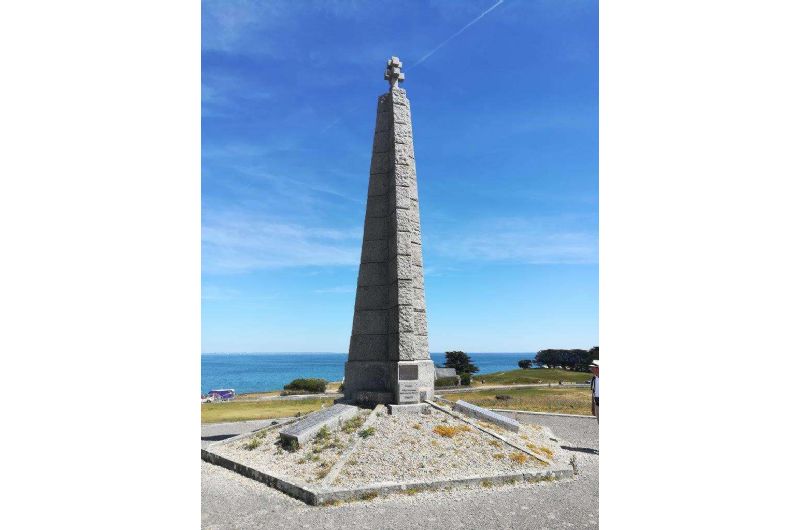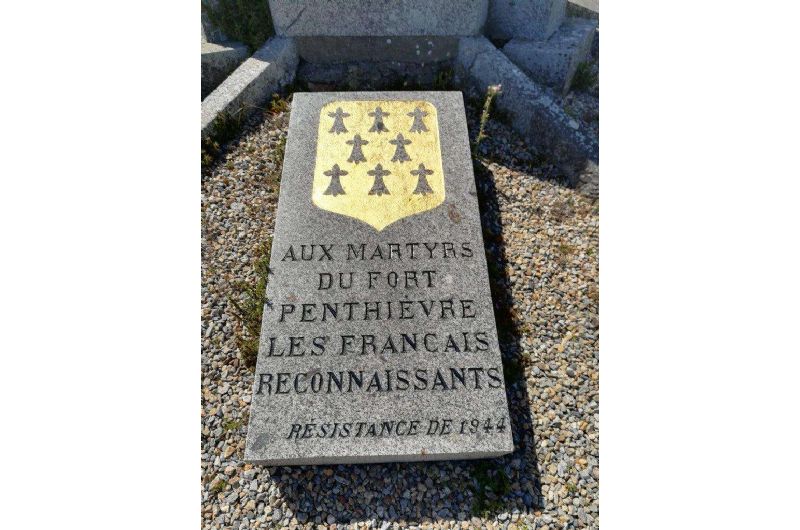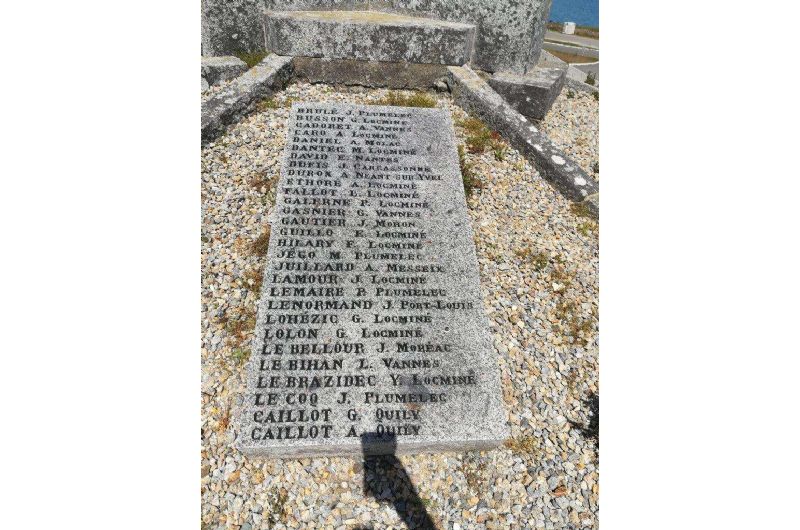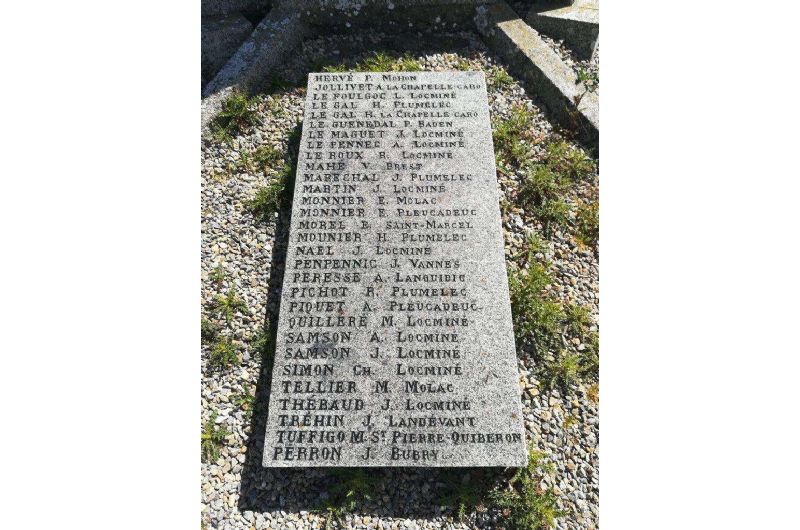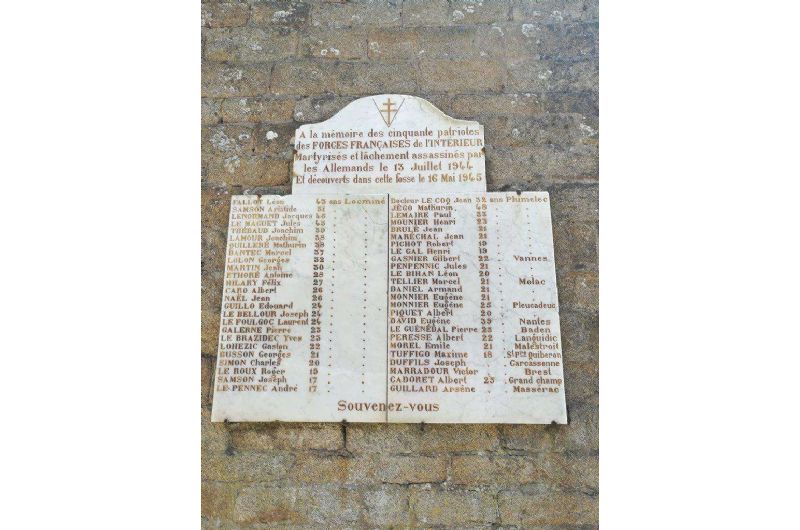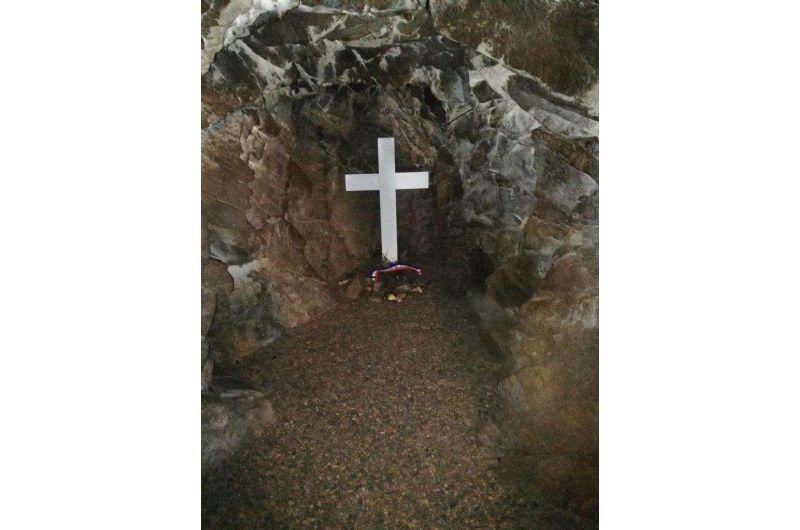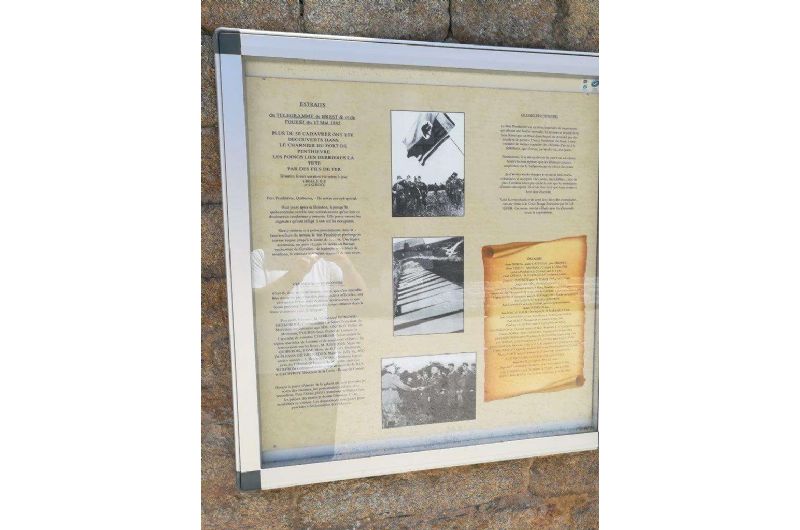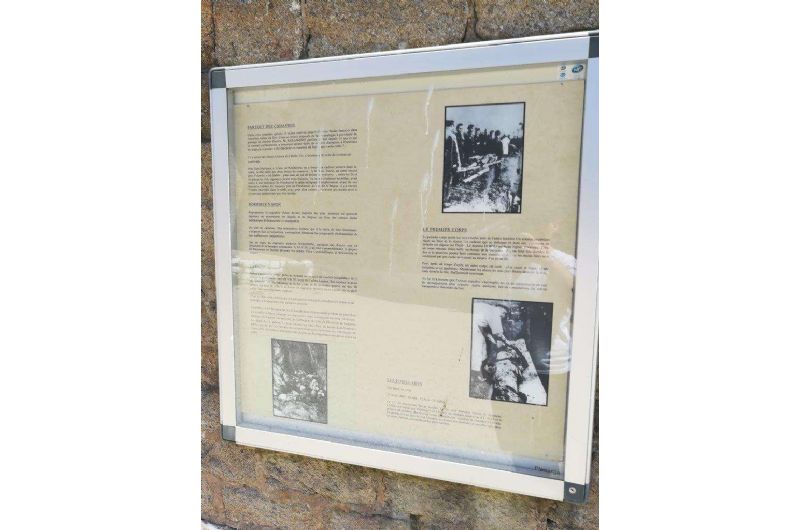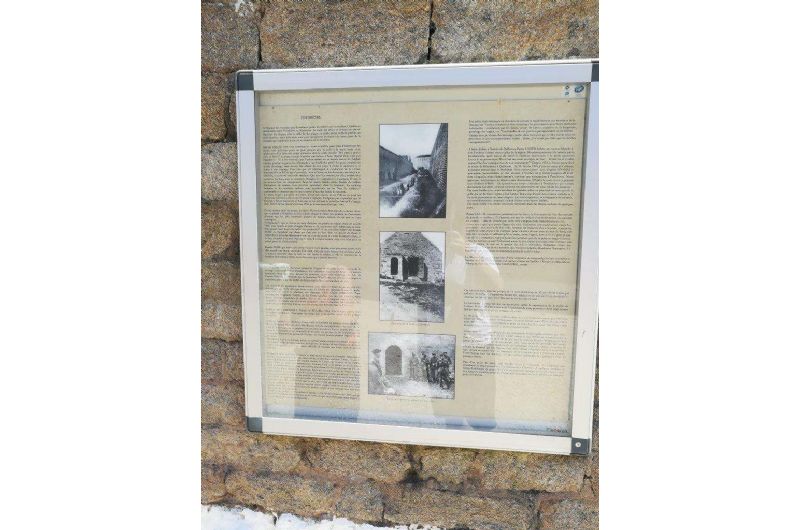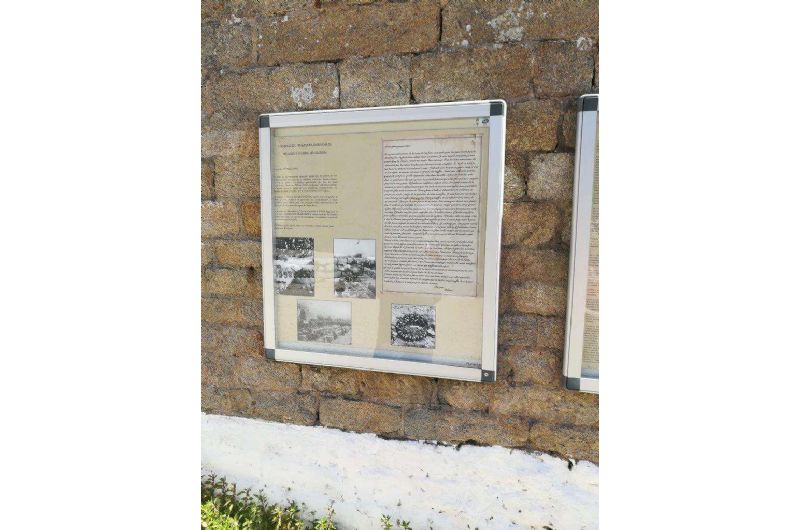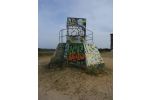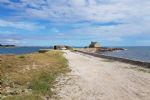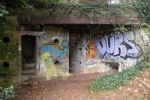During the World War II, the German forces incorporated this structure into their Atlantic Wall scheme. It also served as a jail and execution site at the end of the war: 59 resistance fighters died there between April and July 1944, including 50 on July 13, 1945. A monument has been erected on the site in their memory.
The 3rd Marine Infantry Regiment of Vannes has used it as a training base since 1969.
Source Wikipedia
Text from one of the signs
PENTHIÈVRE
At vacation time few.of the thousands of cars heading to Quiberon slow down between Penthièvreand Kerhostin. The road is straight and everyone is in a hurry to get there. On either side, the fine sand of the gently sloping beaches sometimes calls for an unscheduled stop, but very few pay attention to the gray mass of the citadel overlooking the sea and standing out against the blue sky.
There are many forts on these shores, and this one offers little more interest than the others, except perhaps for a little boy who, shovel in hand, is diligently trying to make a miniature copy of it in the wet sand -Dis papa what's the point of this fort?" Dad, busy launching his boat, replies in a less than impatient voice: "It was built by Vauban when we were fighting the English, then during the war the Germans shot people there". The kid wants to know more, but his dad's busy demeanor makes him swallow his question and get back to work. Maybe if he asked the driver of the car with German plates that stopped at the bottom of the path leading to the citadel, his curiosity would be satisfied. Who knows? The tourist, indeed, seems to know the place well, but if, as I imagine, he stayed here some 27 years ago, he'll find it much changed. Under the skilful hands of a dozen naval infantrymen, all specialized construction workers, the damp corridors and dark dungeons have been transformed into a comfortable, dapper "place of residence" that has nothing to envy many a tourist hotel. The young sergeant guiding my visit was not yet born in 1944, and can't tell me much about what went on there at the time. He is aware, however, that 59 Frenchmen were massacred there, and although it's not the first time he's entered the narrow passage found in May 1945, I sense that he's as moved as I am.
In these last months of the war, the Saint -Pierrots were far from suspecting what was going on inside the fort, near which it was not prudent to venture, especially as those most interested had good reason not to be noticed.
"L'Alphonse", whom I find watering his salad plants, being one of them. "It was heavy the tray loaded with weapons and munitions that had to be slid silently through the night to the beard of the sentinels". He advises me to go and see Rosalie BURE and, recalling his dog who has taken a cool dip in a flower bed, he takes back his watering can. Now all that's in the past, there was work to be done, he did it, period. Night after night, he risked his skin, but he doesn't want to talk about it, it was natural for him.
Rosalie BURE, who lives in a small house nearby, is no longer young, but she has kept a good memory. She and another local woman were the only ones allowed into the fort, where they cooked, and she remembers how the unfortunate people interned there were treated.
On July 13, 1944, 53 Patriots from Vannes, flanked by der Gestapo agents, arrived at Port-Penthièvre. The next morning at 10 a.m., they were taken two by two before the pelotons d'exécution composed of S.S. from the Vlassov army commanded by Lieutenant Wassilenko, a Georgian, a half-crazed drunkard, placed under the orders of Lieutenant Stilling, commander of the fort.
The dead and dying were then thrown into a narrow gut at the foot of the vats, which was walled off so that all trace of the crime would disappear.When 10 months, 'l later or opened the mass grave, it was discovered, relates Claude DERVENN "that some of the tortured had had their lips stapled with barbed wire, presumably to prevent them from screaming . On the rock, one could still make out the bloody traces of the hands that had clutched it; in the darkness, half-asphyxiated, dying men had tried to write with their blood, one last time: "Vive...".
The affair had begun in Vannes on July 12, 1944. With American troops advancing rapidly, the occupying forces were not keen for them to find the prisons occupied.
Here are the statements made byMajor Esser coastal defense battalion chief of the 894c R I. to the 'tribunal Militaire de la IIIe Région during his trial: "That day, the head of the garrison Gestapo came to Colonel Reese, whose H.Q. was based in Arradon, and asked him to shoot a group of 50 Frenchmen who were being held in the Vannes prison. They were mostly from Locminé.
Without discussion and even with a certain eagerness the colonel agreed and gave me the order to carry out the sentence. I tried to get rid of this chore, arguing that it would be difficult to dig a pit in the rocky terrain.
Pioneers would have to be brought in and the rock blown up with dynamite But no accomplice having taken heed of my observations, I therefore had to carry out the order. in case of refusal to obey I would have been brought before the War Council and my family placed in a concentration camp. As there had never been any executions in the battalions under my command, I asked the colonel's H.Q. for instructions.
Assistant officer Lieutenant Sperl replied that such matters were not dealt with over the phone that all I had to do was carry out the order given to me conscientiously and to the best of my ability, as was natural for an officer who only knew how to fight chivalrously, honorably, in a military manner - without causing anyone suffering, providing a dignified burial, because I thought these men had nevertheless wanted the best for their homeland, but that unfortunately they had used means not recognized by International Law"
After referring to their executions he added: "I did things as well as I could and despite the walled-in pit, which was necessary for hygiene,it must have been a game to find out;
A room was set up as a torture chamberand regularly these gentlemen from the Vannes Gestapo came to the fort to interrogate the prisoners with their usual methods: hanging by the feet, beating with sticks, bathtub torture, nail pulling, etc. "The families of these poor guys didn't know where they were. Every day, I took out messages rolled up in my bodice, so they could be warned and a correspondence established. Dame, the Krauts wouldn't have had to find out".
In Saint Julien, at the entrance to Quiberon, Pierre LANTIL lives in a white house with a slate roof, like all the others in the region. Prematurely retired from the Gendarmerie for health reasons, he now fishes when his strength allows. He is one of the few survivors of Fort - Pentièvre and today suffers the consequences of his internment "Since 1943, I was part of the Ist Resistance network in Quiberon. On February 10, 1944, I was at the Crameur camp, the first to be attacked in Morbihan. Four of us were killed. and I were arrested. I was sent to Vannes, where I stayed until April 20, when around sixty of us were taken to Penthièvre. Of course, we didn't know our destination at the outset. From the route we took, I first thought Belle-Îfe, but we stopped at Penthièvre, which was in no way equipped to receive prisoners, as we were the first. We were searched and put in the large rooms where later we were thrown straw which soon became nothing more than manure. Many of us were sick and there was no one to look after us. Interrogations, accompanied by torture, began immediately and eight of us were shot. A wedding party rounded up in Locminé came to join us, but were released after a few days...
Pierre LANTIL knew the place inside out, the fort having been one of his childhood playgrounds. He was well aware that garbage was discharged into the sea through a pipe. The idea of escaping by this route immediately occurred to him.
Having noticed that for the evening roll call, the German adjutant, having arranged the prisoners all around their room, turned for a moment to the door, from which he began to count them, to stop in front of those on the back wall, his plan was quickly established. All he had to do was hide in the bread oven before roll call, and one of his comrades, counted among the first by the door, would quickly line up among the last when the German's back was turned. Alas, on the evening when the plan was put into effect, the adjutant was accompanied by one of his men, who stayed at the door and thwarted the plan. The fugitive was soon discovered and thoroughly beaten.
On May 30, 1944 a group of some twenty comrades he was driven back to Vannes, where he was shot in August. The others had been shot in Rennes or deported to Germany, of whom one René CHANEREL, returned.
The apparent good faith, an amalgam of naiveté (?) discipline and love of a job well done" of the Nazi regime's servants is well reflected in the words of this little 52-year-old schoolteacher (Esser was not a career soldier).
Lieutenant Ming was impeached after the surrender of the Lorient pocket. He also had to his credit the murder of five people, two of whom were burned alive after being doused with petrol.
Geogian brute Mu was killed in Elven in circumstances that are still unclear. According to some accounts, before being shot, he managed to pretend to be touched, let himself fall from his horse and killed several F.F.I. who believed him dead with a burst of machine-gun fire.
Certainly not all the German soldiers occupying the peninsula were "bloodthirsty tigers". Pierre Lantil is deeply grateful to one of them who, at the risk of his own life, took over from Rosalie BURE to deliver the mail, and did so on his own initiative. Without being asked, out of simple humanity. Better still, he convinced one of his comrades to do the same. The owner of ''Hôtel le Thonier, which faces the Fort, was a child at the time, corn he remembers that, having to go with a comrade to the mainland to sit an exam, permission was granted and German soldiers guided them through the mined passages.
More than a quarter of a century has passed. With dusk, bathers abandoned the beach to dine at the terrace of the "Thonier". A few hundred meters away, the granite obelisk erected in memory of the victims stands out in the night for their liberty. The lights installed for the next day's ceremonies remind them of the price paid for their freedom.
During the World War II, the German forces incorporated this structure into their Atlantic Wall scheme. It also served as a jail and execution site at the end of the war: 59 resistance fighters died there between April and July 1944, including 50 on July 13, 1945. A monument has been erected on the site in their memory.The 3rd Marine Infantry Regiment of Vannes has used it as a training base since 1969.Source WikipediaText from one of the signs PENTHIÈVRE At vacation time few.of the thousands of cars heading to Quiberon slow down between Penthièvreand Kerhostin. The road is straight and everyone is in a hurry to get there. On either side, the fine sand of the gently sloping beaches sometimes calls for an unscheduled stop, but very few pay attention to the gray mass of the citadel overlooking the sea and standing out against the blue sky. There are many forts on these shores, and this one offers little more interest than the others, except perhaps for a little boy who, shovel in hand, is diligently trying to make a miniature copy of it in the wet sand -Dis papa what's the point of this fort? Dad, busy launching his boat, replies in a less than impatient voice: It was built by Vauban when we were fighting the English, then during the war the Germans shot people there. The kid wants to know more, but his dad's busy demeanor makes him swallow his question and get back to work. Maybe if he asked the driver of the car with German plates that stopped at the bottom of the path leading to the citadel, his curiosity would be satisfied. Who knows? The tourist, indeed, seems to know the place well, but if, as I imagine, he stayed here some 27 years ago, he'll find it much changed. Under the skilful hands of a dozen naval infantrymen, all specialized construction workers, the damp corridors and dark dungeons have been transformed into a comfortable, dapper place of residence that has nothing to envy many a tourist hotel. The young sergeant guiding my visit was not yet born in 1944, and can't tell me much about what went on there at the time. He is aware, however, that 59 Frenchmen were massacred there, and although it's not the first time he's entered the narrow passage found in May 1945, I sense that he's as moved as I am. In these last months of the war, the Saint -Pierrots were far from suspecting what was going on inside the fort, near which it was not prudent to venture, especially as those most interested had good reason not to be noticed. L'Alphonse, whom I find watering his salad plants, being one of them. It was heavy the tray loaded with weapons and munitions that had to be slid silently through the night to the beard of the sentinels. He advises me to go and see Rosalie BURE and, recalling his dog who has taken a cool dip in a flower bed, he takes back his watering can. Now all that's in the past, there was work to be done, he did it, period. Night after night, he risked his skin, but he doesn't want to talk about it, it was natural for him.Rosalie BURE, who lives in a small house nearby, is no longer young, but she has kept a good memory. She and another local woman were the only ones allowed into the fort, where they cooked, and she remembers how the unfortunate people interned there were treated. On July 13, 1944, 53 Patriots from Vannes, flanked by der Gestapo agents, arrived at Port-Penthièvre. The next morning at 10 a.m., they were taken two by two before the pelotons d'exécution composed of S.S. from the Vlassov army commanded by Lieutenant Wassilenko, a Georgian, a half-crazed drunkard, placed under the orders of Lieutenant Stilling, commander of the fort. The dead and dying were then thrown into a narrow gut at the foot of the vats, which was walled off so that all trace of the crime would disappear.When 10 months, 'l later or opened the mass grave, it was discovered, relates Claude DERVENN that some of the tortured had had their lips stapled with barbed wire, presumably to prevent them from screaming . On the rock, one could still make out the bloody traces of the hands that had clutched it; in the darkness, half-asphyxiated, dying men had tried to write with their blood, one last time: Vive.... The affair had begun in Vannes on July 12, 1944. With American troops advancing rapidly, the occupying forces were not keen for them to find the prisons occupied.Here are the statements made byMajor Esser coastal defense battalion chief of the 894c R I. to the 'tribunal Militaire de la IIIe Région during his trial: That day, the head of the garrison Gestapo came to Colonel Reese, whose H.Q. was based in Arradon, and asked him to shoot a group of 50 Frenchmen who were being held in the Vannes prison. They were mostly from Locminé.Without discussion and even with a certain eagerness the colonel agreed and gave me the order to carry out the sentence. I tried to get rid of this chore, arguing that it would be difficult to dig a pit in the rocky terrain. Pioneers would have to be brought in and the rock blown up with dynamite But no accomplice having taken heed of my observations, I therefore had to carry out the order. in case of refusal to obey I would have been brought before the War Council and my family placed in a concentration camp. As there had never been any executions in the battalions under my command, I asked the colonel's H.Q. for instructions. Assistant officer Lieutenant Sperl replied that such matters were not dealt with over the phone that all I had to do was carry out the order given to me conscientiously and to the best of my ability, as was natural for an officer who only knew how to fight chivalrously, honorably, in a military manner - without causing anyone suffering, providing a dignified burial, because I thought these men had nevertheless wanted the best for their homeland, but that unfortunately they had used means not recognized by International LawAfter referring to their executions he added: I did things as well as I could and despite the walled-in pit, which was necessary for hygiene,it must have been a game to find out; A room was set up as a torture chamberand regularly these gentlemen from the Vannes Gestapo came to the fort to interrogate the prisoners with their usual methods: hanging by the feet, beating with sticks, bathtub torture, nail pulling, etc. The families of these poor guys didn't know where they were. Every day, I took out messages rolled up in my bodice, so they could be warned and a correspondence established. Dame, the Krauts wouldn't have had to find out. In Saint Julien, at the entrance to Quiberon, Pierre LANTIL lives in a white house with a slate roof, like all the others in the region. Prematurely retired from the Gendarmerie for health reasons, he now fishes when his strength allows. He is one of the few survivors of Fort - Pentièvre and today suffers the consequences of his internment Since 1943, I was part of the Ist Resistance network in Quiberon. On February 10, 1944, I was at the Crameur camp, the first to be attacked in Morbihan. Four of us were killed. and I were arrested. I was sent to Vannes, where I stayed until April 20, when around sixty of us were taken to Penthièvre. Of course, we didn't know our destination at the outset. From the route we took, I first thought Belle-Îfe, but we stopped at Penthièvre, which was in no way equipped to receive prisoners, as we were the first. We were searched and put in the large rooms where later we were thrown straw which soon became nothing more than manure. Many of us were sick and there was no one to look after us. Interrogations, accompanied by torture, began immediately and eight of us were shot. A wedding party rounded up in Locminé came to join us, but were released after a few days... Pierre LANTIL knew the place inside out, the fort having been one of his childhood playgrounds. He was well aware that garbage was discharged into the sea through a pipe. The idea of escaping by this route immediately occurred to him.Having noticed that for the evening roll call, the German adjutant, having arranged the prisoners all around their room, turned for a moment to the door, from which he began to count them, to stop in front of those on the back wall, his plan was quickly established. All he had to do was hide in the bread oven before roll call, and one of his comrades, counted among the first by the door, would quickly line up among the last when the German's back was turned. Alas, on the evening when the plan was put into effect, the adjutant was accompanied by one of his men, who stayed at the door and thwarted the plan. The fugitive was soon discovered and thoroughly beaten. On May 30, 1944 a group of some twenty comrades he was driven back to Vannes, where he was shot in August. The others had been shot in Rennes or deported to Germany, of whom one René CHANEREL, returned. The apparent good faith, an amalgam of naiveté (?) discipline and love of a job well done of the Nazi regime's servants is well reflected in the words of this little 52-year-old schoolteacher (Esser was not a career soldier). Lieutenant Ming was impeached after the surrender of the Lorient pocket. He also had to his credit the murder of five people, two of whom were burned alive after being doused with petrol. Geogian brute Mu was killed in Elven in circumstances that are still unclear. According to some accounts, before being shot, he managed to pretend to be touched, let himself fall from his horse and killed several F.F.I. who believed him dead with a burst of machine-gun fire. Certainly not all the German soldiers occupying the peninsula were bloodthirsty tigers. Pierre Lantil is deeply grateful to one of them who, at the risk of his own life, took over from Rosalie BURE to deliver the mail, and did so on his own initiative. Without being asked, out of simple humanity. Better still, he convinced one of his comrades to do the same. The owner of ''Hôtel le Thonier, which faces the Fort, was a child at the time, corn he remembers that, having to go with a comrade to the mainland to sit an exam, permission was granted and German soldiers guided them through the mined passages. More than a quarter of a century has passed. With dusk, bathers abandoned the beach to dine at the terrace of the Thonier. A few hundred meters away, the granite obelisk erected in memory of the victims stands out in the night for their liberty. The lights installed for the next day's ceremonies remind them of the price paid for their freedom.Contribution & photo credit Fabrice Bourrée (Fondation de la Résistance )

